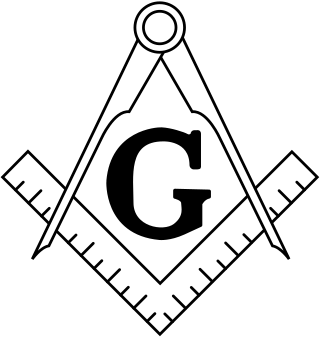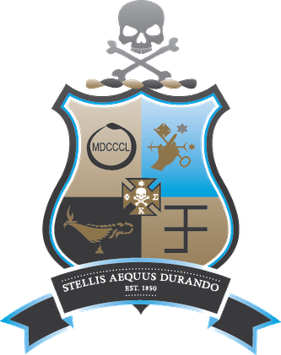
Freemasonry or Masonry refers to fraternal organisations that trace their origins to the local guilds of stonemasons that, from the end of the 14th century, regulated the qualifications of stonemasons and their interaction with authorities and clients. Modern Freemasonry broadly consists of two main recognition groups: Regular Freemasonry, which insists that a volume of scripture be open in a working lodge, that every member professes belief in a Supreme Being, that no women be admitted, and that the discussion of religion and politics do not take place within the lodge; and Continental Freemasonry, which consists of the jurisdictions that have removed some, or all, of these restrictions.

The Mausoleum at Halicarnassus or Tomb of Mausolus was a tomb built between 353 and 350 BC in Halicarnassus for Mausolus, an Anatolian from Caria and a satrap in the Achaemenid Empire, and his sister-wife Artemisia II of Caria. The structure was designed by the Greek architects Satyros and Pythius of Priene. Its elevated tomb structure is derived from the tombs of neighbouring Lycia, a territory Mausolus had invaded and annexed c. 360 BC, such as the Nereid Monument.

Pierce County is a county in the U.S. state of Washington. As of the 2020 census, the population was 921,130, up from 795,225 in 2010, making it the second-most populous county in Washington, behind King County, and the 60th-most populous in the United States. The county seat and largest city is Tacoma. Formed out of Thurston County on December 22, 1852, by the legislature of Oregon Territory, it was named for U.S. President Franklin Pierce. Pierce County is in the Seattle metropolitan area.

Golders Green Crematorium and Mausoleum was the first crematorium to be opened in London, and one of the oldest crematoria in Britain. The land for the crematorium was purchased in 1900, costing £6,000, and the crematorium was opened in 1902 by Sir Henry Thompson.

Sigma Nu (ΣΝ) is an undergraduate college fraternity founded at the Virginia Military Institute in 1869. Since its founding, Sigma Nu has chartered more than 279 chapters across the United States and Canada and has initiated more than 235,000 members. It is part of the Lexington Triad, a trio of national fraternities that were founded at colleges in Lexington, Virginia.

The Eye of Providence is a symbol depicting an eye, often enclosed in a triangle and surrounded by a ray of light or a halo, intended to represent Providence, as the eye watches over the workers of mankind. A well known example of the Eye of Providence appears on the reverse of the Great Seal of the United States, which is depicted on the United States one-dollar bill.
Afterglow is an atmospheric phenomenon.

Phi Sigma Pi National Honor Fraternity (ΦΣΠ) is a gender-inclusive/mixed-sex national honor fraternity based in the United States. The fraternity is a 501(c)(3) not-for-profit organization incorporated in the state of Pennsylvania to foster scholarship, leadership, and fellowship. Phi Sigma Pi chapters are at more than 140 four-year collegiate institutions.

Acacia Fraternity, Inc. is a social fraternity founded in 1904 at the University of Michigan in Ann Arbor, Michigan. The fraternity has 27 active chapters and 3 associate chapters throughout Canada and the United States. The fraternity was founded by undergraduate Freemasons and was originally open only to men who had taken the Masonic obligations, but in 1933 the International Conclave elected to dispense with the Masonic prerequisite. In 1988, at the 45th Conclave, the fraternity elected to use "International" rather than "National" when referring to the fraternity.

Phi Beta Sigma Fraternity, Inc. (ΦΒΣ) is a historically African American fraternity. It was founded at Howard University in Washington, D.C., on January 9, 1914, by three young African-American male students with nine other Howard students as charter members. The fraternity's founders, A. Langston Taylor, Leonard F. Morse, and Charles I. Brown, wanted to organize a Greek letter fraternity that would exemplify the ideals of Brotherhood, Scholarship and Service while taking an inclusive perspective to serve the community as opposed to having an exclusive purpose. The fraternity exceeded the prevailing models of Black Greek-Letter fraternal organizations by being the first to establish alumni chapters, youth mentoring clubs, a federal credit union, chapters in Africa and a collegiate chapter outside of the United States. It is the only fraternity to hold a constitutional bond with a historically African-American sorority, Zeta Phi Beta (ΖΦΒ), which was founded on January 16, 1920, at Howard University in Washington, D.C., through the efforts of members of Phi Beta Sigma.

Westminster College is a private college in Fulton, Missouri. It was established in 1851 as Fulton College. America's National Churchill Museum is a national historic site located on campus. The school enrolled 609 students in 2020.
Bill Baarsma is an American politician and academic who served as the 37th mayor of Tacoma, Washington from 2001 to 2009.

Phi Kappa Sigma (ΦΚΣ) is an international all-male college secret society and social fraternity. Commonly known as “Skulls”, the name is inspired by the skull and crossbones on the fraternity's badge and coat of arms. Members are often recognized by the solid gold membership pin depicting the fraternity’s symbol, a Maltese Cross surrounding a human skull. The fraternity is one of the world’s oldest and most successful social fraternities, developing generations of leaders in politics, law, business, professional sports, and military service. From 1886 through 1980, there was at least one Skull serving in the United States Senate. The 94-year history of Skull’s involvement in the upper chamber was broken when Richard Schweiker retired from the Senate to serve as Secretary of Health and Human Services under the administration of President Ronald Reagan.

Donald Holman McLean was an American Republican Party politician who represented New Jersey's 6th congressional district in the United States House of Representatives from 1933 to 1945.
Phi Omega Pi (ΦΩΠ) was a national collegiate sorority operating in the United States from 1922 until 1946 when its chapters were absorbed by several larger sororities, and merged with the national sorority, Delta Zeta.

Roche Harbor is a sheltered harbor on the northwest side of San Juan Island in San Juan County, Washington, United States, and the site of a resort of the same name. Roche Harbor faces Haro Strait and the Canada–United States border. The harbor itself provides one of the better protected anchorages in the islands. The harbor is surrounded on the east side by San Juan Island, on the north side by Pearl Island, and on the west and south sides by Henry Island. Most of the harbor is 35 to 45 feet deep. Roche Harbor has a small airport used primarily by local residents.

Concordia was a steamboat that ran on Puget Sound from 1930 to 1976. Although later converted to diesel power, Concordia was the last inland commercial steamboat ever built on either Puget Sound or the Columbia river.
John Stafford McMillin was an American lawyer, businessman and political figure. Born in Sugar Grove, Indiana, McMillin attended DePauw University and became a member of the Sigma Chi fraternity. He practiced law in Lafayette before moving to Washington Territory, where he became the president and general manager of the Tacoma Lime Company, a limeworks.

James Thomas Harrison was an American lawyer and Democratic politician. He served in both houses of the Mississippi Legislature and was the Lieutenant Governor of Mississippi from 1900 to 1904.
















